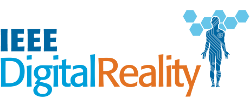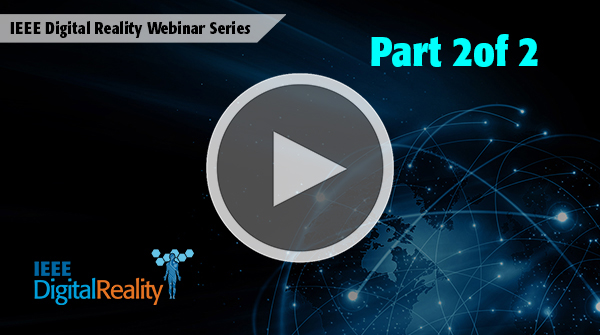Recorded Webinars
Recorded Webinars
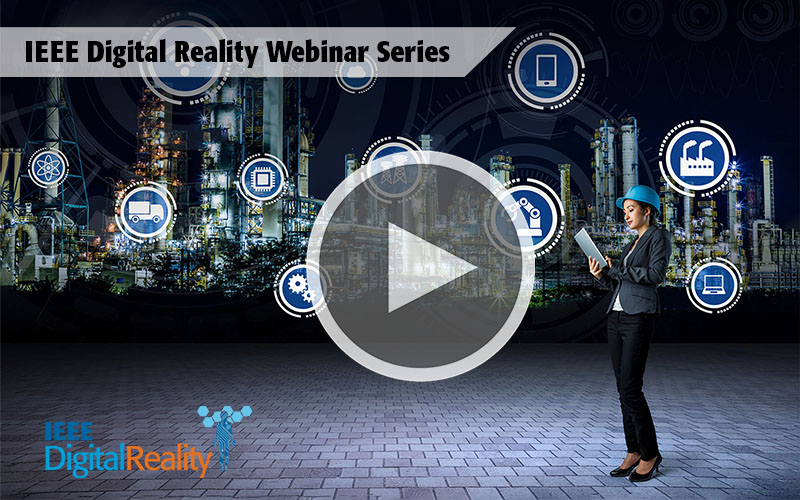 Digital Twin Opportunities with Augmented Reality
Digital Twin Opportunities with Augmented Reality
The market opportunity for digital twins and other forms of advanced visualization is significant – with demonstrated potential to transform the world of work as we know it. While attention around the potential of the metaverse has put a greater focus on all types of mixed reality technology, AR represents an immediate opportunity for businesses to enhance productivity and improve operational efficiency.
In this webinar, Magic Leap and NavVis discussed the enterprise applications and value that can be delivered by using digital twins in production environments, warehouses, offices and retail stores. The presentation also provided an overview of the technical aspects of localization and 3D mapping in complex business environments.
Featured Speakers: Ignacio Perez Hallerbach, VP and Global Head of Partners and Platform, NavVis and Jade Meskill, VP of Product, Magic Leap
Click here to access the event on-demand.
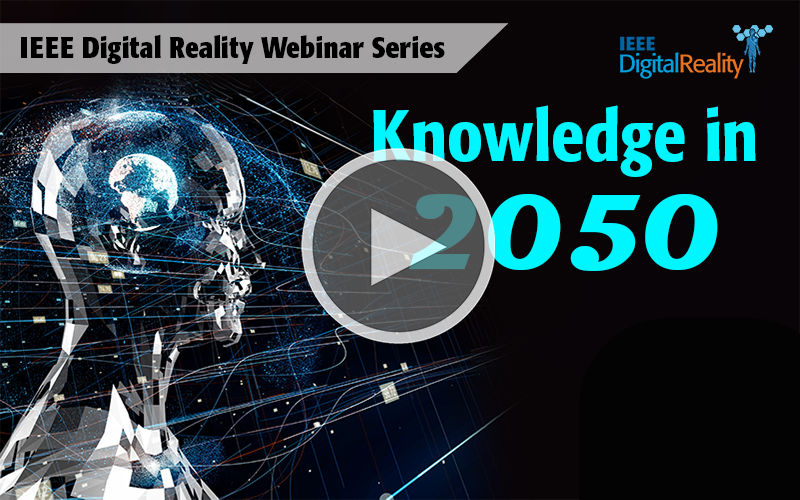 Knowledge in 2050
Knowledge in 2050
During this free, virtual webinar, Roberto Saracco, IEEE Digital Reality co-chair, explained Personal Digital Twins. The concept of applying Digital Twins to model a person is already underway, but very few have attempted to model a whole person—the physical, emotional, cognitive, and behavioral aspects. Learn more about Cognitive Digital Twins: a digital twin of yourself, focusing on the unique knowledge you have, and any you might need or acquire in the future.
This event highlights some of the ways in which the IEEE Digital Reality Initiative has contributed to the research on Cognitive Digital Twins. In addition, Dr. Saracco demonstrates why IEEE will need to transition from a trusted repository of knowledge to a trusted, knowledge-transfer service provider.
Featured Speaker: Roberto Saracco, IEEE Digital Reality Co-Chair
Click here to access the event on-demand.
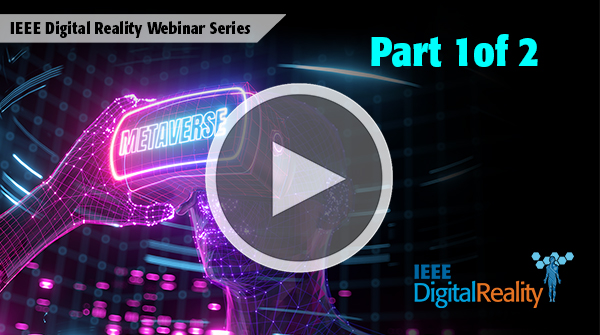 Mastering the Metaverse Across Industry Part 1 • Part 2
Mastering the Metaverse Across Industry Part 1 • Part 2
During this special two-part webinar, four experts from different disciplines defined the Metaverse in their own terms and delve into potential use-cases for leveraging the Metaverse across a multitude of industries, including public services.
Technologies and Business of the Metaverse featuring Derrick and Roberto
In early June 2022, during the first part of the event, Derrick de Kerckhove and Roberto Saracco present The Technologies and Business of the Metaverse. Roberto explored the history and evolution of Digital Twins, and how They are related to the Metaverse. Later in the talk, Derrick explains and defines the metacity.
Click here to access Part 1 available for free on-demand.
Mastering the Metaverse Across Industry Part 2
View of the Metaverse from the Guttenberg Galaxy featuring Vitaly
AND
Interwoven Spaces: Bringing the Real and Virtual Worlds Together, featuring Dr. Alboul
During the second part of the event, Vitaly Kazakov presented the View of the Metaverse from the Gutenberg Galaxy, and Dr. Lyuba Alboul discussed Interweaving Spaces - Bringing the Real and Virtual Worlds Together. Both events provided participants an exclusive opportunity to join two live Q&A sessions.
Watch Part 1 and Part 2 to learn more and discover Digital Twins, Smart cities, the Metaverse, and other technologies being developed (such as AR/VR/MR/XR).
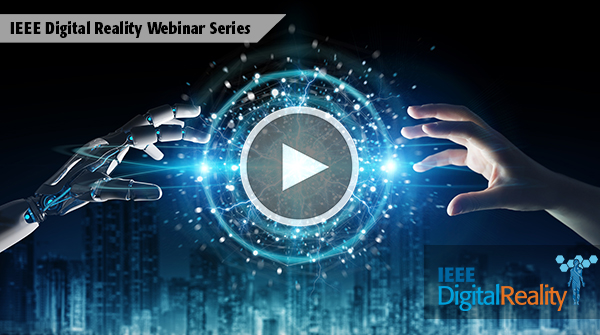 Power of AI: Introducing AI Literacy Globally
Power of AI: Introducing AI Literacy Globally
The AI market is projected to grow to $190 Billion by 2025. AI is being used in every industry and is projected to be a core skill for the future. We are shifting to a new phase of AI development, where broad segments of the non-technical workforce are encountering AI in their job roles. This is both exciting and fraught with peril. Instances of AI failures, legal issues, and ethical issues are rising. There is pressure on AI development to accommodate not just data scientists, but people from all walks of life. To achieve the next levels of returns from AI, we require technologies and solutions that combine AI and human intelligence.
In this talk, we discussed recent AI and Machine Learning technology trends and what it will take to bring AI knowledge out of the technical domain and into the broader workforce, and technology trends, like low-code, that enable broad adoption. We then discussed a framework for AI Literacy – the Four Cs – and experiences of bringing AI literacy to individuals worldwide.
Featured Speaker: Nisha Talagala
CEO and Founder of AIclub.world
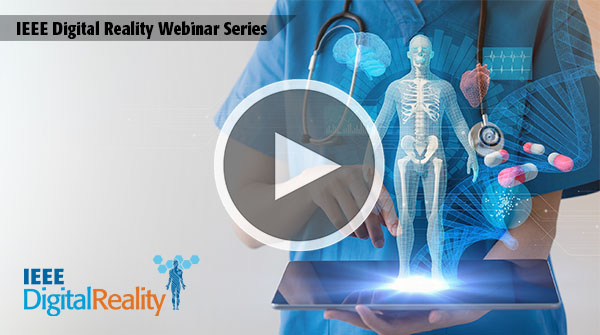 Power of AI: Pioneering Drug Discovery with Insilico Medicine
Power of AI: Pioneering Drug Discovery with Insilico Medicine
Drug discovery is one of the most complex, risky, and lengthy areas of human development. It takes many highly-intelligent and highly-skilled experts in biology, chemistry, and medicine to discover a drug. It is known that artificial intelligence thrives on data, especially on big datasets of high quality. Fortunately, there is a lot of data generated at each step of the drug discovery process, making it a lucrative application for modern AI technologies.
During our webinar on 20 April 2022, participants had the opportunity to learn more about how AI can transform the discovery of medicine. Petrina Kamya, Frank Pun, and Ján Szöllös from Insilico Medicine explained how their AI system, including their biology-solving engine PandaOmics and compound-generating engine Chemistry42, is built on years of modeling large biological, chemical, and textual datasets. The featured speakers presented innovative and refined approaches to expand to other therapeutic areas and find more novel drug candidates that will become future medicines levering AI and ML
Featured Speakers:
• Petrina Kamya, PhD, Global Business Development Director for Chemistry42, Insilico Medicine
• Frank Pun, Associate Director, Application Science Lead, Insilico Medicine
• Ján Szöllös, MBA, Business Development DirectorInsilico Medicine
 Power of AI: AI/ML in the Era of 5G and Beyond
Power of AI: AI/ML in the Era of 5G and Beyond
AI/ML and 5G are a perfect match sharing a mutually beneficial relationship. While 5G offers very high speeds for enhanced mobile broadband (eMBB), support for a massive number of devices (mMTC), and ultra-reliable low latency communications (URLLC). AI/ML complements the technology by learning from complex patterns to provide scope for autonomous network operations, transforming 5G into a scalable real-time network that is data-driven. To optimize performance, AI/ML is used across all layers — from disaggregated radio access networks (RAN), to integrated access backhauls (IAB), to the distributed cloud layer (Edge/Core). Just as AI/ML is useful for 5G network operations, 5G is useful for AI/ML by providing multiple points of presence for data collection & computing, control loops that can operate in multiple time scales to support distributed intelligence, deployment automation, and orchestration for the life cycle management of models.
In this webinar, we covered the role of AI/ML to support data-driven 5G operations to include slice management, fault prediction, security, the interplay of AI/ML with edge computing, how AI/ML is being leveraged for O-RAN, and opportunities for autonomous network operations. We also shared progress being made in the IEEE Future Networks Initiative's AI/ML working group, and the roadmap items being considered for 5G and beyond networks.
This webinar was a collaboration between IEEE Digital Reality and IEEE Future Networks. Future Networks dedicates an entire chapter to AI/ML in their roadmap project, the INGR (International Network Generations Roadmap). To access that and the other chapters of the INGR roadmap, visit https://futurenetworks.ieee.org/roadmap
 Power of AI: the Future of Public Transportation
Power of AI: the Future of Public Transportation
What if buses didn’t have predefined routes? It’s an easy enough question to describe and, even without being steeped in the world of optimization, logistics, or even transportation, one can come up with many different visions of how a bus system without bus lines may function. That is the beauty and the curse of the question....
To actively optimize decisions of which bus goes where, when, and what services are available, an on-demand system is simultaneously vital and extremely difficult. Yet decisions made by such a system can be scrutinized by anybody who has ridden a bus.
In this talk, Alex Wallar described how such a transit system operates, how The Routing Company has been able to optimize the routes for thousands of vehicles in real-time, and how demand-responsive bus systems can pave the way for equitable transportation for all.
Featured Speaker: Alex Wallar
Co-founder and CTO of The Routing Company
Benefits and Challenges of Autonomous Vehicles
Driverless vehicles are not a new concept, and several autonomous vehicles have been designed, tested, and even used for different purposes. However, the implementation of such an enhanced technology cannot happen overnight.
Covid-19 has significantly increased the need and demand for autonomous vehicles, bringing to light concerns pertaining to policies, ethics, attainability, standards, etc. Autonomous Vehicles can change life as we know it, and there are several benefits gained from the implementation and use of this technology, however, there are also a lot of challenges.
This presentation provided an overview of the autonomous vehicle market demands, current players, vehicle statuses, and challenges. In addition, areas of public safety and product safety were discussed.
Featured Speaker: Samina Husain
IEEE Senior member
Broadcast Technology Society (BTS) Secretary
Member of the IEEE Future Directions (FDC) and Women in Engineering (WIE) Committees
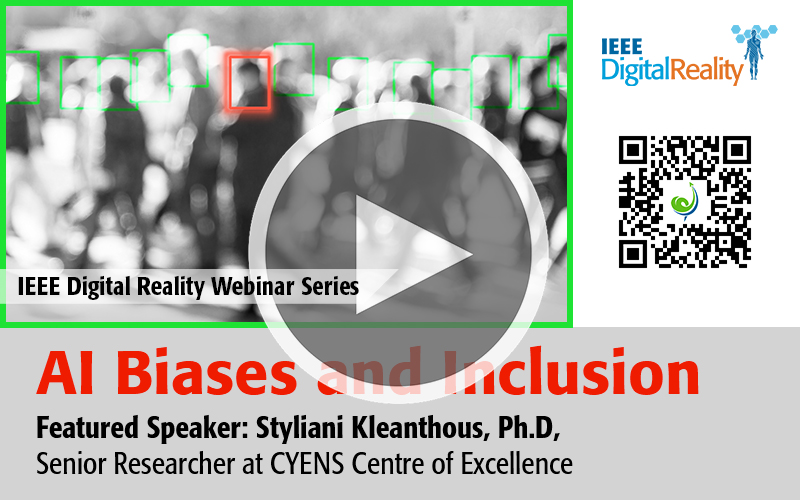 AI Biases and Inclusions
AI Biases and Inclusions
Recently, image analysis algorithms have become widely available as Cognitive Services. This practice is proving to be a boon to the development of applications where user modeling, personalization, and adaptation are required. However, while tagging APIs offers developers an inexpensive and convenient means to add functionality to their creations, most are opaque and proprietary, and there are numerous social and ethical issues surrounding their use in contexts where people can be harmed.
In this talk, Dr. Styliani Kleanthous discussed her recent work in analyzing proprietary image tagging services (e.g., Clarifai, Google Vision, Amazon Rekognition) for their gender and racial biases when tagging images depicting people. Dr. Kleanthous presented techniques for discrimination discovery in this domain, as well as her work on understanding a user and the developers' perceptions of fairness. Finally, she explored sources of such biases by comparing human vs machine descriptions of the same people/images.
Featured Speaker: Dr. Styliani Kleanthous
PhD, Senior Researcher at the Cyprus Center for Algorithmic Transparency
Open University of Cyprus and CYENS Centre of Excellence
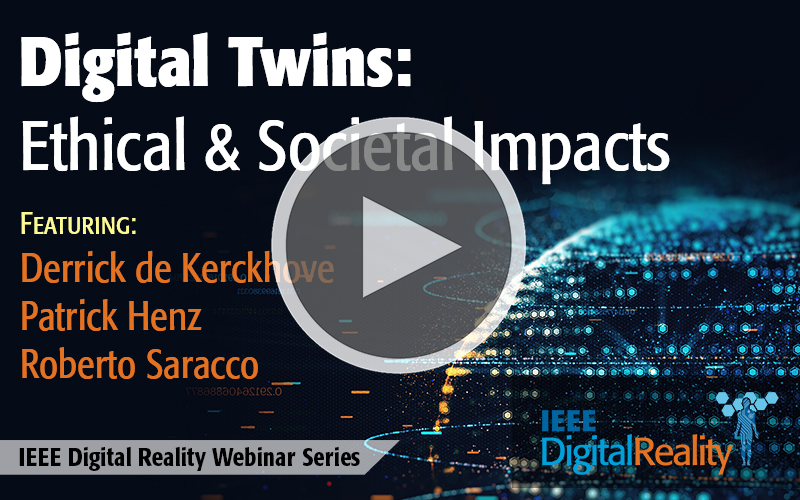 Digital Twins: Ethical and Societal Impacts
Digital Twins: Ethical and Societal Impacts
Digital Twins are becoming increasingly pervasive in the industry, and they are now being used to generate digital replicas to mirror individual human beings, their unique behaviors, their expertise, and even their emotions. This brings us into an unchartered territory where new ethical questions arise.
During this webinar, Roberto Saracco presented the latest evolutions of Digital Twin technology and applications. Saracco, Patrick Henz, and Derrick de Kerckhove, the presenters, focused on the applications of Personal Digital Twins in healthcare and for the modeling of a biological person to the modeling of the cognitive person. The former opens the application space for simulation of bio-processes, the latter the simulation and replication of cognitive processing.
The second part of the webinar explored the ethical implications arising from the creation of Personal Digital Twins, and the fading boundary between the physical and the Digital world—a world in which a Personal Digital Twin behaves as an avatar of the physical person and the Physical Space. In such a scenario, people would be perceiving a seamless continuum extended in the Digital Space, behaving in a new Digital Reality framework. This is, in a way, creating a new reality, like the one “invented" by the Surrealism artistic movement (spearheaded by Dali).
The third part of the webinar explored societal aspects of Cognitive Digital Twins, both at a perceptual level and at a society/organizational level, taking the general impact on the workplace and social interactions into consideration.
Featured Speakers:
• Derrick de Kerckhove, Scientific Director at Media 2000
• Patrick Henz, Head of Governance, Risk & Compliance US
• Roberto Saracco, IEEE Digital Reality Co-Chair
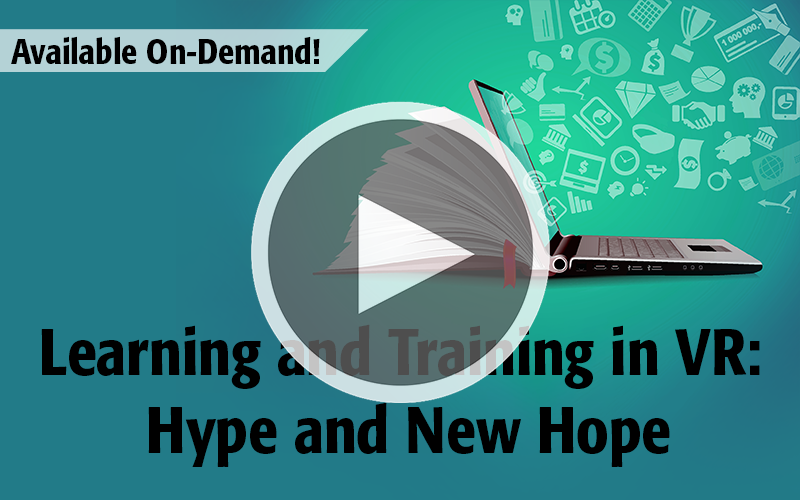 Learning and Training in VR: Hype and New Hope
Learning and Training in VR: Hype and New Hope
The ability for Virtual Reality (VR) to create rich and compelling experiences drives research in a variety of domains beyond entertainment. One such area of interest is the use of VR for learning and training purposes. Indeed, learning and training have been a central topic in VR ever since successful flight simulators decades ago. The allure of VR for training is not only due to the ability to synthesize realistic conditions for situations where on-site training is expensive, dangerous, or difficult to replicate in real life, but also due to the ability to create extreme, unrealistic conditions to over-prepare trainees for the real situation. Full control over the visual and auditory experience of the user, as well as some control over haptic feedback, makes for an engaging training experience and ensures the reproducibility of training sessions. Combined with recent advances in light and untethered headsets, tracking, interaction, and VR authoring tools, various industrial immersive learning applications show promising results. The explosive potential of VR-based collaboration in the post-pandemic era, where remote and non-contact work environments became the new normal, further accelerated the adoption of VR-based training in broader use cases.
Despite the large media coverage of VR training stories for various industrial applications, there are still mixed scientific reports on the efficacy and measurable performance improvements depending on significant factors such as the domain of training, implementation, level of engagement and interaction, and the complexity of skills and tasks. In this talk, Professor Choi presented the taxonomy of learning and training in VR/AR/MR and discussed the status of technological advances and limitations. Beyond visual and auditory-focused immersion, kinesthetic learning for fine motor skills poses a new challenge for VR-based training. Developing the ability to perform a new skill, and retaining that ability, requires repetitive coordination of the brain and muscles (sports training in VR is a prime example). Can the complex motor skills required in sports be learned in VR? If so, do these skills transfer to the real world? Can it provide a lasting impact similar to real-world training? This talk also addressed core endeavors focused on feedback and adaptive training mechanisms.
Featured Speaker: Dr. Min Hyung Choi, Computer Science & Engineering Professor, University of Colorado Denver
 AI Systematic Errors - Who Is Responsible?
AI Systematic Errors - Who Is Responsible?
In contrast to humans, all decisions made by algorithms are systematic and based on user data, sensors, and algorithms. The question is, who is responsible for errors: the provider, the integrator, or the end-user? In most scenarios, responsibility is distributed amongst all stakeholders. Full autonomic systems (including self-driving technology) are not accepted by lawmakers, and a human supervisor is demanded as a backup.
Thanks to behavioral science, research knows that humans can be influenced and manipulated by Artificial Intelligence. This is comparable to the animal kingdom in which an alpha rules the pack, but the beta is able to manipulate the alpha. Accountability from all sides (including creators, integrators, and users) is required to reduce systematic errors and the related effects on humans, such as falling to biases (like the over-trust of Artificial Intelligence and status pressure), leading to mission and commission error.
System-thinking, as described by W. Edwards Deming in his “System of Profound Knowledge,” can exemplify the direction – AI decision-making must be transparent, audited, and understood by humans. Even more, humans need to be aware that responsibility stays with them. This means they not only have to accept accountability for decisions but must also directly create AI-based on Deming’s philosophy. For everything else, Deming concluded that “a bad system will beat a good person every time.” An increasing number of government officials are demanding the inclusion of behavioral science into acceptable corporate behavior. This can result in a greater moral responsibility amongst creators and providers of AI for their technology, in addition to a legal and sanctionable influence.
Featured Speaker: Patrick Henz, Head of Governance, Risk & Compliance US Regional Compliance Officer Americas
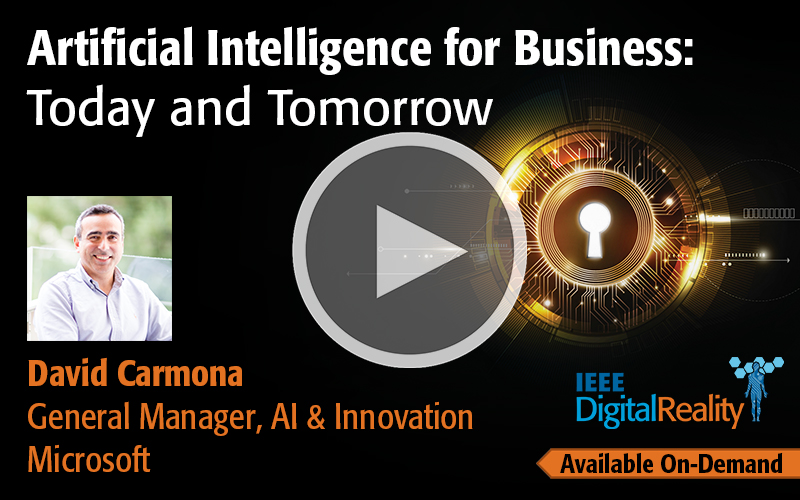 Artificial Intelligence for Business: Today and Tomorrow
Artificial Intelligence for Business: Today and Tomorrow
Just like every company is now a software company, every business will soon become an Artificial Intelligent (AI) business. In this talk, David Carmona, Microsoft’s General Manager for AI and Innovation, discussed the key technological trends that will fuel that revolution, including massive AI models trained on supercomputers, autonomous systems that learn with humans, augmented intelligence, and responsible AI.
Featured Speaker: David Carmona, General Manager of AI and Innovation at Microsoft
 The Future of Digital Twins
The Future of Digital Twins
Digital Twins were defined approximately 15 years ago, and it took them about 7 years to become adopted by the manufacturing industry, first by General Electric and then several others. However, in the last five years, they have been applied in an increasing number of sectors, from building construction to healthcare, and they have evolved significantly from the original idea of being a digital mirror of an object.
Now, their evolution is accelerating both in terms of application and capabilities, extending their coverage to mirror people (from deep twins to cognitive twins). In addition, they are continuously acquiring an increasing amount of intelligence, all aspects of which are being addressed by the IEEE Digital Reality Initiative.
In this decade, we are expecting to reach a point where everything, including each of us, will be flanked by its own digital twin. The European Union has recently committed funding to create a digital twin of our planet: Destination Earth.
As they evolve, and particularly as they enter into our lives, new challenges are created by technology. Challenges that are rooted in our social lives and in our culture are coming to the forefront.
In this webinar, the speakers shared views on the ongoing Digital Twin evolution, as well as address the societal and personal issues that are emerging.
Featured Speakers: Derrick de Kerchove, Scientific Direction at Media 2000 and Roberto Saracco, IEEE Digital Reality Co-Chair
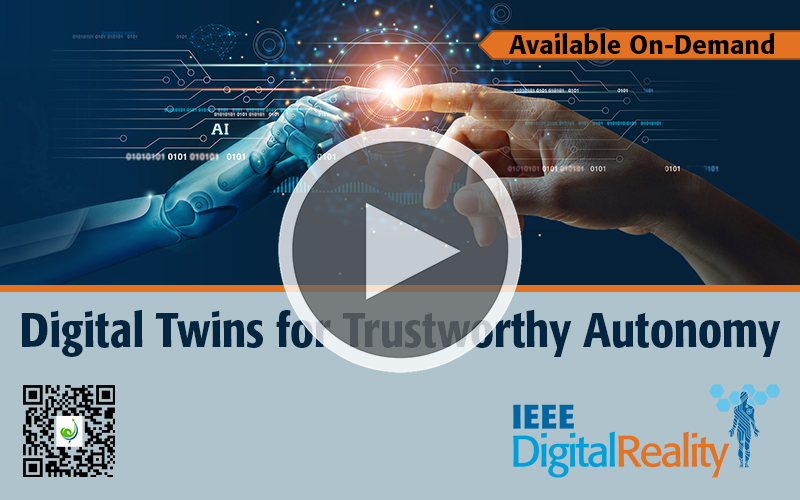 Digital Twins for Trustworthy Autonomy
Digital Twins for Trustworthy Autonomy
The next generation of run-time risk models will act as digital Twins to anticipate threats and enable novel paradigms, like proactive dependability and collaborative security, as support to prognostics and preventive maintenance in Industry 4.0 and other smart-X applications (e.g.,smart-houses, smart-cities, smart-transportation, etc.).
The concept of risk is a combination of threat probabilities, vulnerabilities, and expected consequences. In traditional risk modeling and evaluation, during the design phase, analyses are performed and may be repeated periodically or at relevant system changes. With such approaches, there is no possibility to evaluate how the risk evolves over time as a condition of actual system state and detected threats. One challenging objective, in the field of connected cyber-physical systems (CPS) and the Internet of Things (IoT), is to improve resilience by providing non-trivial mechanisms for run-time threat detection, risk estimation, and system reconfiguration following Self-X principles like self-diagnostics and self-healing. Threats include faults, errors, and failures, and can be either intentional (e.g. security attacks) or unintentional (e.g. random faults).
Models used in static risk assessment during the design phase can be reused and integrated into appropriate frameworks. This will allow online monitoring of relevant system parameters, threat detection, and dynamic adaptation to respond to threats. In critical applications, the reuse of suitable models already employed for system certification together with run-time model-checking supports explainable Artificial Intelligence (XAI) that is required in order to build a trustworthy autonomous CPS, such as a self-driving vehicle.
Featured Speaker: Professor Francesco Flammini
Professor of Computer Science at Mälardalen University
Technical Manager of a RAILS EU Project
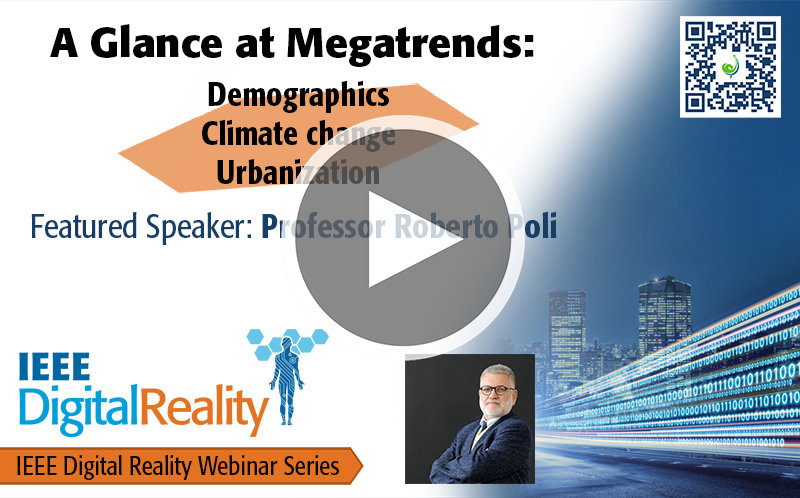 A Glance at Megatrends: Demographics, Climate change, and Urbanization
A Glance at Megatrends: Demographics, Climate change, and Urbanization
This webinar described three megatrends, the related windows of opportunity (when available), and exemplified their countertrends.
The human population continues to grow at a rapid pace, and naturally, resources will be diminished, environmental pollution will increase, and the use of technologies will transform. By recognizing patterns, researchers can identify a series of changes that have been in progress for many years, typically for decades. These changes are known as Megatrends and are likely to have effects well into the future.
Megatrends have to do with major transformations that influence many other changes, profoundly altering social forms and mechanisms, and affecting diverse economic sectors. They are so deeply ingrained in the functioning of modern societies that it is almost impossible to change a megatrend unless there are exceptional circumstances (windows of opportunity). Moreover, they are often accompanied by secondary trends that move in the opposite direction.
Featured Speaker: Professor Roberto Poli
Department of Sociology and Social Research, University of Trento
UNESCO Chair in Anticipatory Systems
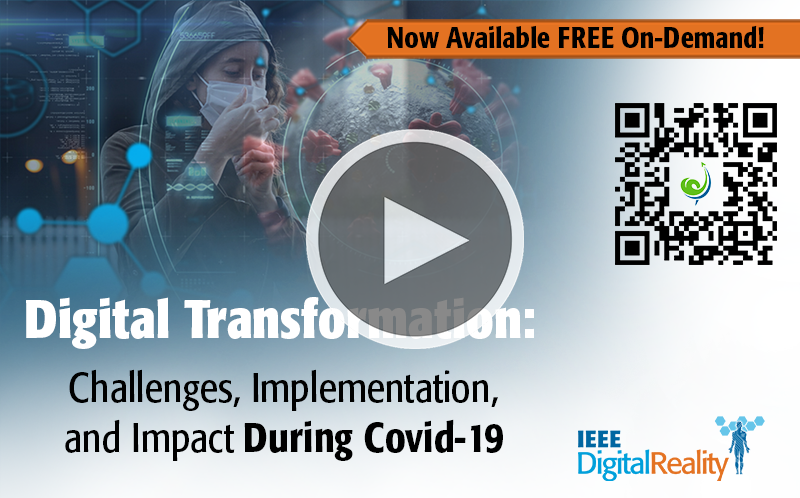 Digital Transformation: Challenges, Implementation, and Impact During COVID-19
Digital Transformation: Challenges, Implementation, and Impact During COVID-19
This webinar focused on Digital Transformation and, in particular, discussed the challenges pertaining to the process and pace of implementation, as well as the impact on the local culture. Subject-matter-expert, Roberto Saracco, discussed the acceleration of the Digital Transformation throughout the COVID-19 pandemic, and shared important and relevant findings extracted from an IEEE Digital Reality whitepaper. written by several of the IEEE Future Directions committee members.
This whitepaper is focused on multiple aspects relating to Digital Transformation and covers the continuously evolving technologies, and how they can and may continue to be used in the future.
Featured Speaker: Roberto Saracco, IEEE Digital Reality Co-Chair
Click here to access the corresponding whitepaper.
 Accelerating Business Growth with IEEE Digital Reality Technologies
Accelerating Business Growth with IEEE Digital Reality Technologies
IEEE Digital Reality is IEEE's catch-all term that encompasses multiple technologies, including Internet of Things (IoT), Artificial Intelligence (AI), Machine Learning, Virtual Reality (VR), Augmented Reality (AR), etc.
In this webinar, Nicholas Napp, the project lead for IEEE's Digital Reality Exchange project, dives into the challenges presented by digital reality projects from the perspective of both project owners, and other stakeholders, such as vendors and consultants. Learn more about how IEEE's Digital Reality Exchange can help overcome those challenges and be instrumental in driving digital transformation within the enterprise.
Featured Speaker: Nicholas Napp, the project lead for IEEE's Digital Reality Exchange project
 Autonomous Things and GPUs
Autonomous Things and GPUs
Software-defined, AI-enabled Autonomous Vehicles (AV) require Graphics Processing Units (GPUs) for developing and running AI and XR end-to-end. GPUs enable the technology to apply deep learning algorithms to complex sensor data in order to produce autonomous actions.
In addition, GPUs are used for the creation of next-generation augmented reality (AR) interfaces, with information pertaining to points of interest, alerts, navigation, and co-pilot support for drivers.
This webinar will provide an overview of the fundamental characteristics of GPUs required to support new functionalities, including architecture, design, and verification points of view. It will also describe how dependability and functional safety need to be considered in order to provide the required level of trust for GPU computing.
Featured Speaker: Riccardo Mariani, VP of Industry Safety at NVIDIA
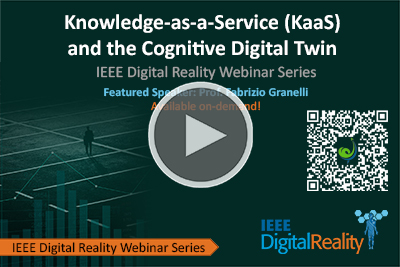 Knowledge-as-a-Service (KaaS) and the Cognitive Digital Twin
Knowledge-as-a-Service (KaaS) and the Cognitive Digital Twin
Knowledge-as-a-Service (KaaS) is a computing service that delivers knowledge to users, as opposed to data or information. KaaS enables technologists and engineers to make knowledge live and evolving on the web by allowing users to learn directly from elaborated knowledge, for example, in the form of knowledge graphs.
By merging KaaS with Artificial Intelligence, it is then possible to define the concept of a Cognitive Digital Twin. A complete cognitive digital twin will act similarly to AI that can make its own decisions, process thoughts, and execute actions, just like a real, functioning organism.
Featured Speakers: Professor Fabrizio Granelli, University of Trento, Italy
 Creating New Realities: Convergence of XR and Robotic Technologies
Creating New Realities: Convergence of XR and Robotic Technologies
The recent advancements in technology and the exponential increase in the use of interconnected devices have drawn significant interest and influenced the development of complex computing systems. Working with the emerging digital technologies of Virtual (VR), Augmented (AR), Mixed Reality (MR), Digital Twins, and Robots has never been more exciting than today. Especially when these technologies are fused together in innovative ways to allow the development of a new amalgamated reality and provide opportunities that may radically change the way we interact with real and artificial agents, our surroundings, and with each other.
This webinar presents a new type of Cyber-Physical-Social Eco-Society (CPSeS) system that implements the idea of ‘technological fusion’ by bringing together Mixed Realities, Robots, and Social Networking to provide engaging and interactive new `realities’. This CPSeS goes beyond current virtual environments experiences by encompassing both physical and virtual spaces using cutting edge robotics technology for actuating, sensing, processing, and guiding purposes, immersive technologies for visualization, and integrating social inputs between users in the real and virtual worlds, creating a disruptive new paradigm that can contribute to the digital transformation of a wide range of domains.
Featured Speakers: Dr. Louis Nisiotis and Dr. Lyuba Alboul
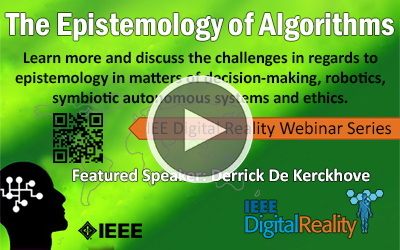 The Epistemology of Algorithms
The Epistemology of Algorithms
All human communications, not to mention those of all primates, most vertebrates, and even insects have been mediated by the production of meaning, from mere utterances to the most evolved media. Algorithms produce meaning too, but they achieve it through a process that doesn’t require an understanding (e.g. Google Translate needs no background information and doesn't always make sense). Hence, humans are unable to influence systematically produced algorithms. This fact may present a challenge to epistemology in matters of decision-making, robotics, symbiotic autonomous systems, and ethics.
Are you knowledgeable about previous pandemics that affected the world? How much of that info do you take into consideration in situations relevant to Covid-19? Learn more about this and the challenges regarding epistemology in matters of decision-making, robotics, symbiotic autonomous systems, and ethics.
Featured Speaker: Derrick de Kerckhove, CEO & Scientific Director for MediaDuemila and Osservatorio TuttiMedia
Click here to access the video
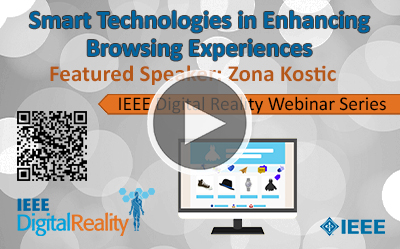 Smart Technologies in Enhancing Browsing Experiences
Smart Technologies in Enhancing Browsing Experiences
Information search is an activity that involves various techniques and methods for finding new insights. Physical and digital spaces as different contexts provide unique advantages for search activities: the physical environment provides spatial layout and interaction with tangible objects, while online information applications support browsing and knowledge discovery.
This talk focuses on systems that aim (or could be used) to bridge the gap between physical and digital arenas, using digital data associated with physically situated objects, and transforming and visualizing this data in relation to a given context. Using portable devices or digital realities headsets, applications generate the object-related data visualizations for further exploration. With such systems and its interplay between real and digital realms, new avenues could be opened for creating in-situ immersive visual experiences.
Featured Speaker: Zona Kostic, Program Director at APUS, Research Scientist at Harvard University
Click here to access the video
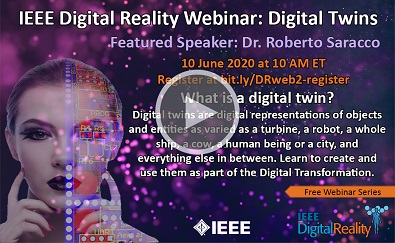 Digital Twins
Digital Twins
Digital Twins are becoming the bridge, the orchestrators in between the cyber and the physical space and technologies like AR/VR/MR are at the same time the tools letting us enter the cyberspace and the manifestation of the cyberspace itself.
This webinar will start with an introduction to Digital Twins, how the concept has evolved in the last 15 years, and how they are now applied in manufacturing, their current market value, and the main players in this area.
Then, the talk will shift to the future, how Digital Twins are evolving right now, how they are becoming an important tool in areas as diverse as Healthcare, Finance, Education, etc. In this evolution, the Digital Reality Initiative is playing a significant role, and this webinar will address the current activities where all of you can be involved.
Featured Speaker: Roberto Saracco, IEEE Digital Reality co-chair and IEEE Future Directions Committee member
Click here to access the video
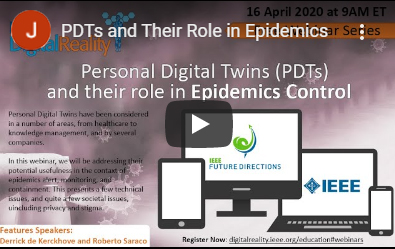 Personal Digital Twins and their role in Epidemics Control
Personal Digital Twins and their role in Epidemics Control
Digital Twins are becoming the bridge, the orchestrators in between the cyber and the physical space and technologies like AR/VR/MR are at the same time the tools letting us enter the cyberspace and the manifestation of the cyberspace itself.
This webinar will start with an introduction to Digital Twins, how the concept has evolved in the last 15 years, and how they are now applied in manufacturing, their current market value, and the main players in this area.
Then, the talk will shift to the future, how Digital Twins are evolving right now, how they are becoming an important tool in areas as diverse as Healthcare, Finance, Education, etc. In this evolution, the Digital Reality Initiative is playing a significant role, and this webinar will address the current activities where all of you can be involved.
Featured Speakers: Roberto Saracco, IEEE Digital Reality co-chair and IEEE Future Directions Committee member, and Derrick de Kerckove, former Director of the McLuhan Program in Culture & Technology at the University of Toronto
Click here to access the video

